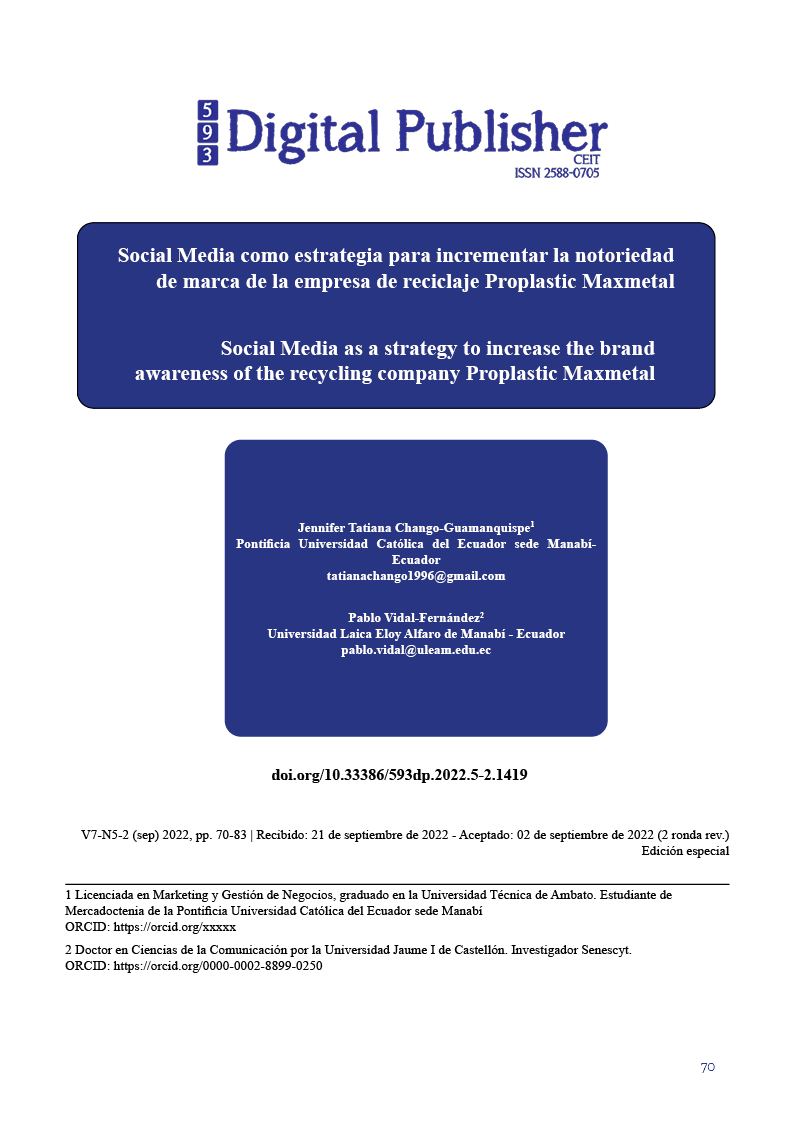Social Media as a strategy to increase the brand awareness of the recycling company Proplastic Maxmetal
Main Article Content
Abstract
The main objective of this research is the main objective of this research was to analyze social media as a strategy to increase the brand awareness of the recycling company Proplastic Maxmetal. As a problem, it was evidenced that the recycling sector presents great changes and trends in the use of technological tools within its internal processes, as well as in those of promotion or dissemination of its services. As a methodology it is based on a descriptive study, with bibliographic-documentary research that used the analysis-synthesis method and field research. The population sample addressed was 384 people from the PEA. As a result, two headings are presented where the current situation of the company in the local context and the proposal of the social media plan are analyzed. Finally, as conclusions, it is presented that brand awareness goes beyond the recognition of the name or logo but involves the ability to remember and influence the decision of products or services.
Downloads
Article Details

This work is licensed under a Creative Commons Attribution-NonCommercial-ShareAlike 4.0 International License.
1. Derechos de autor
Las obras que se publican en 593 Digital Publisher CEIT están sujetas a los siguientes términos:
1.1. 593 Digital Publisher CEIT, conserva los derechos patrimoniales (copyright) de las obras publicadas, favorece y permite la reutilización de las mismas bajo la licencia Licencia Creative Commons 4.0 de Reconocimiento-NoComercial-CompartirIgual 4.0, por lo cual se pueden copiar, usar, difundir, transmitir y exponer públicamente, siempre que:
1.1.a. Se cite la autoría y fuente original de su publicación (revista, editorial, URL).
1.1.b. No se usen para fines comerciales u onerosos.
1.1.c. Se mencione la existencia y especificaciones de esta licencia de uso.
References
Álvarez, V., Erazo, J., Narváez, C., & Erazo, C. (2019). Plan de social media como estrategia de posicionamiento de marca aplicado a la empresa Importadora Zumbauto. Visinario Digital, 2(2), 261-283. doi:https://doi.org/10.33262/visionariodigital.v3i2.2.640
Asaftei, L. (2017). La atención al cliente en los Medios Sociales. Tesis de Administración de Empresas. Baliarica: Universitat de les Illes Balears.
Cajamarca, E., Jimbo, J., & Cabrera, S. (2022). Study of the supply chain of recicled paper and cardboard in the city of Cuenca-Ecuador. Ciencias Administrativas, 20, 2314-3738.
Cano, S. (2017). La notoriedad de la marca Promart en la campaña publicitaria Tu Familia es Perfecta. Lima: Universidad de San Martin de Porres.
Córdova, C., Marcillo, M., & Paredes, A. (2022). Desarrollo de branding como experiencia de aula: estudio de caso marca Popula Visual. Ciencia Latina, 6(2), 2976-2989. doi:https://doi.org/10.37811/cl_rcm.v6i2.2067
Del Alcázar, J. (2021). Ecuador Estado Digital. Obtenido de Mentinno: https://www.mentinno.com/estadodigitalecuador/
Férnández, J. (2011). Diseño'e'implementación'de'un'plan'de'Social'Media' Marketing'(o'Marketing'2.0)'en'la'Biblioteca'de'la Universidad'de'Cádiz. Máster universitario en bibliotecas y servicios de información digital. Madrid, España: Universidad Carlos III Madrid.
Guillen, L. H. (2018). Las herramientas tecnológicas TIC´s como elemento alternativo para el desarrollo del componente físico (ICT technological tools as an alternative element for the development of the physical component). Retos: Nuevas Tendencias en Educación Física, Deporte y Recreación(34), 222-229.
Heredia, D., Hurtado, J., Gamboa, J., Mancheno, M., & Astudillo, V. (2022). Administración del reciclaje, tendencia económica post pandemia que se suma a la transición digital de la oferta. Dominio de las Ciencias, 8(1), 375-393.
Hernández Sampieri, R. F. (2010). Metodología de la Investigación. Mexico: McGRAW-HILL.
Hernández, T. (2020). Factores clave para el desarrollar un plan de social media marketing. EUMED. Obtenido de https://www.eumed.net/rev/oel/2020/02/factores-plan-marketing.html
Hosta, M., & Zabkar, V. (2021). Antecedents of environmentally and socially responsible sustainable consumer behavior. Journal of Business Ethics, 171(2), 273-293. doi:https://doi.org/10.1007/s10551-019-04416-0
Hoyos, R. B. (2016). Branding el arte de marcar corazones. Bogotá: Ecoe Ediciones.
INEC. (Noviembre de 2020). Información Ambiental en Hogares ESPND. Obtenido de https://www.ecuadorencifras.gob.ec/documentos/web-inec/Encuestas_Ambientales/Hogares/Hogares%202019/MOD_AMB_HOGAR_ESPND_2019_11.pdf
INEC. (2021). Fascículo Provincial Tungurahua. Obtenido de https://www.ecuadorencifras.gob.ec/wp-content/descargas/Manu-lateral/Resultados-provinciales/tungurahua.pdf
Leyva, J., & Guerra, Y. (2020). Objeto de investigación y campo de acción: componentes del diseño de una investigación científica. EDUMECENTRO, 12(3), 241-260.
López, D., Peñalosa, M. L., & De la Vega, L. (2022). La lealtad de marca y el consumidor colombiano en época de Covid-19. Face, 2(2), 4-13.
López, G., & López, G. (2022). El consumidor responsable. Lumina, 23(2), E0020. doi:https://doi.org/10.30554/lumina.v23.n2.4413.2022
López, S., Villamón, M., & Añó, V. (2019). Conceptualisation of Social Media: opportunities for Sport Management. Retos, 36(xxx-xxx), 1579-1726.
Maigua, C. M., & Lascano, L. F. (2022). Evolución del marketing mix y la creación de valor de marca en las cooperativas de ahorro y crédito. Visionario Digital, 6(1), 113-128. doi:https://doi.org/10.33262/visionariodigital.v6i1.2139
Merisavo, M. (2018). The interaction between digital marketing communication and customer loyalty. Acta Universitatis oeconomicae Helsingiensis(122), 333.
Naranjo, E., Crespo, L., Ayala, L., & García, N. (2022). Uso indebido de marcas en las plataformas digitales que limitan las actividades económicas. Universidad y Sociedad, 14(4), 675-682. Obtenido de https://rus.ucf.edu.cu/index.php/rus/article/view/3094
Quinde, F., & Cahuasquí, E. (2022). Valor de marca Café. Sathiri: Sembrador, 17(2), 47-66. doi:https://doi.org/10.32645/13906925.1130
Rangel, J., Yance, L., & Andrade, M. (2021). Las redes sociales como medio de emprendimiento. Reciamuc, 60-69. doi:https://doi.org/10.47464/reciamuc/5.(4).noviembre.2021.60-69
Ríos, D., & Almeida, R. (2022). The influence of trust and value on Brand loyalty in students of private institutions of higher education. Revista Pérspectivas(49), 9-34.
Sánchez, C. (2019). Social media. desarrollo del plan de social media de una empresa. Tesis de ciencias económicas y empresariales. Madrid, España: Universidad Pontificia Comillas.
Solorzano, J., & Parrales, M. (2021). Branding: posicionamiento de marca en el mercado ecuatoriano. Revista Espacios, 42(12), 1-13. doi:10.48082/espacios-a21v42n12p03
Ugalde, C., Vila, N., & Küster, I. (2018). Brand awareness and brand credibility leading to brand identifcation. Obra digital(15), 63-76.



